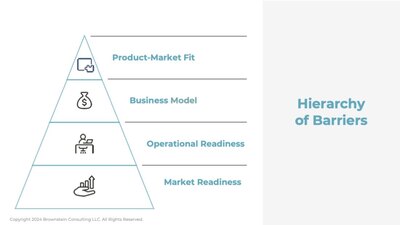News & PublicationsBroadening Perspectives in Healthcare Excellence
|
|
 A few months ago, I had the privilege of speaking at the MIT Sloan School of Management's Health Systems Initiative. In my presentation, I introduced a model for integrating new technologies within healthcare, drawing parallels to Maslow's hierarchy of needs. Just as Maslow's model addresses individual needs from the ground up, the adoption of healthcare technology similarly requires a foundational approach. This blog post outlines a strategic framework designed to tackle the barriers to technology adoption in healthcare, inspired by the structure of Maslow’s hierarchy. Building from the Base: For those unfamiliar, Maslow’s hierarchy begins with basic physiological needs and ascends towards self-actualization. In the context of healthcare technology, adoption must also start from the most fundamental aspects:
Market Readiness: The Foundation of Adoption Market readiness is essential, encompassing the structural, cultural, and regulatory aspects needed for any new technology to succeed:
Operational Readiness: Assessing the Situation on the Ground Once the market is ready, the focus shifts to the specific healthcare organizations that will use the technology:
Business Model: Ensuring Economic Viability A clear and viable business model is crucial for the technology's longevity and success:
Product-Market Fit: Aligning Product with Need The final layer ensures that the technology aligns with the market’s urgent needs:
Conclusion: A Tiered Approach to Overcoming Barriers Just as Maslow's hierarchy guides the fulfillment of human needs, our structured approach can guide healthcare organizations through the complex process of technology adoption. By building from the ground up—starting with market readiness and moving through operational readiness, business modeling, and product-market fit—organizations can effectively integrate new technologies into the healthcare landscape. As technology advances and other market aspects change, barriers also shift. We specialize in assessing these barriers to adoption and developing strategies to overcome them. If you're interested in learning how we can help your business navigate these challenges, click below to schedule a 30-minute introductory call.
0 Comments
|
Archives
May 2024
Categories |
Copyright 2011- 2024 Brownstein Consulting, LLC
Proudly powered by Weebly
 RSS Feed
RSS Feed